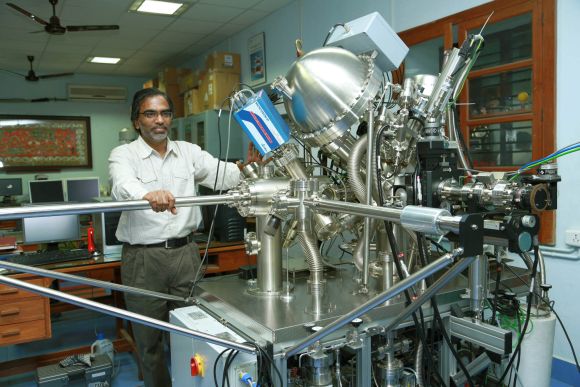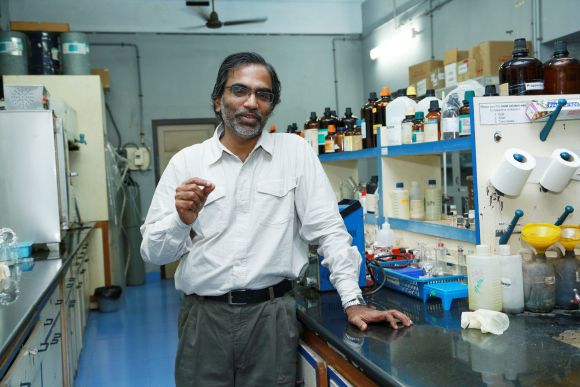
Prof T Pradeep talks about the nano material he and his associates have fabricated and how it can be used in an affordable water filter in an interview with Rediff.com's Shobha Warrier.
Professor T Pradeep is a professor of Chemistry at IIT, Madras, with research interests in molecular and nanoscale materials. One of the notable inventions of the professor with about 50 patents is the material he and his students invented at the IIT, Madras lab named, Biopolymer-reinforced synthetic granular nanocomposites. They created a material at room temperature without contamination. Though the material can be used for many purposes, he has tested it for use in purification of water.
Prof Pradeep received his PhD from the Indian Institute of Science and had post-doctoral training at the Lawrence Berkeley Laboratory, University of California, Berkeley and Purdue University, West Lafayette.
He is a recipient of several awards including the Shanti Swaroop Bhatnagar Prize, BM Birla Science Prize, National Award for Nanoscience and Nanotechnology and the India Nanotech Innovation Award.
He is an author of many books on nanotechnology.
Did you start working on developing a water filter because of the water pollution in India?
If you can provide clean water, you have provided solution for almost everything: education, development, nation building, etc. If a child is kept away from school because of diarrhoea, a part of his life is affected.
I was interested in the problem in 2003 largely because there was this huge issue of pesticide contamination in Kasargode in Kerala. We wanted to use the material that we developed there. We found that nano materials can break pesticides such as endosulfan. That became our first effort and a patent application in 2004.
Did you try to take it to the market?
Yes, we worked with Eureka Forbes to take it to the market as a product. In 2007, they introduced this product in the market. That became the first nano-chemistry based water product ever in the world.
When water flows on the nano particles, water containing the pesticide interacts with the nano particles and the pesticides breaks down, and finally it becomes clean water.
When we introduced this, many people said nano technology should not be used in water, etc. But I was of the view that the unusual chemistry that happens on nano surfaces would be the way to decontaminate water.
People in India have been using gold and silver for purification for ages.
...

How did the world react to your idea of using nano technology in water purification at that time?
In 2003, nobody was looking at using nano materials in water purification. Everybody was looking at nano in high density data storage, computing, cancer therapy, etc. All these are important but we cannot leave out mundane things. So it was not appreciated and it was difficult to sell that idea to people that nano (technology) can be used for water purification.
Was it discouraging for you as a scientist?
You get discouraged every day as a scientist but you have to push yourself. I pushed this idea because I felt this was the direction I should take.
Was the product commercially successful?
I think they are selling some 25,000 pieces a month. It must have crossed a million pieces now.
After pesticides, did you start working on any other contaminants?
Yes, that was how we moved ahead. There are many more contaminants in water like arsenic, lead, etc. That was the next phase of our activity. From 2006 onwards, we started working in that direction. The idea was to create an all inclusive purifier. People don't want just pesticide free water; they want clean water. The idea was that the solution should work for India, it shouldn't work on electrical power and it should not depend on piped water.
So much is the population density and so much is the faecal matter around us that water here contains lots of microbial content. Water continuously gets polluted here in India because that is the way we are; because right from your religious activities to your final funeral pyre, everything is done near water.
What was the next contaminant you worked on?
We looked at a series of things starting from fluorides, arsenic and more and more of specific contaminants like microbes like bacteria and viruses. It is an ongoing process. Now, we have over 35 patents on different aspects of water purification.
After the last five years of work, we have created a sand-like material made in water at room temperature, without releasing any impurity into the water sources used. What it means is, we have made a material by green synthesis. Here, we make a material as strong as sand at room temperature in water. But if you put it back in water, it won't dissolve.
These are nano materials, composite materials which can clean up arsenic or pesticide or any such contaminant in water. We call it Biopolymer-reinforced synthetic granular nanocomposites. This will be effective to purify water of all contaminants.
Once we have microbially safe water, we need to have chemically safe water, then organic-free water and pesticide free water. How do you first remove microbes? Probably by using silver because it is an effective anti-microbial agent. We found that by continuously releasing silver into water for a concentration of 50 parts per billion, we can free water of microbes, but continuously releasing it is difficult. It is like a constant release drug like material. So, we used the new nano material.
We were constantly creating materials. By keeping them all together at various proportions, we can create a water purifier. That is the idea.
Our discovery is to create a material at room temperature without contamination. This can be used for other purposes too. We have only tested its use for water purification.
...

How long did it take you to create the material?
It took us five years and we must have spent several crores of rupees, largely funded by the government. We have a startup with participation from IIT, Madras to take this technology forward.
So many other companies have come out with water filters. For example, Tata's Swach says it also uses nano technology. How different is what you have created?
There is nobody who has come out with a nano material based water filter like we have. Tata Swach has only an anti-microbial solution. It doesn't remove other things like pesticides, arsenic, fluorides. Yes, they are working on it.
I would like to say that every solution is important in water segment. The need is huge. No one person can solve the kind of water problem we have in India.
Have you used the material anywhere?
After pesticides, we used it to remove arsenic. So, the government asked us to install prototypes in the arsenic affected areas in West Bengal. For over one year, we tried it in the field and it was successful. Now, the government has asked us to have 2,000 new installations in various parts of West Bengal.
How are you going to use the nano material in a water filter?
I am now looking at this as a domestic solution for clean water. We are now talking to people in the industry. If it has to reach individuals, industry has to step in.
The cost will be around Rs 500-600 for first time installation and Rs 100-125 in a year for a family for clean microbially, chemically safe water. It will take an hour for water to get clean. We have already made the prototypes.
We believe that frugal science based on nanotechnology can make a lasting impact on society. There are over 200 million households in India. Dissemination of this technology in various forms such as cartridges, sachets, etc. can generate large employment opportunities in villages. The production of composites and water filter devices and their deployment and servicing can contribute to the local economy.
I can also say that this material will not add any footprint -- energy or carbon, on this planet. That is why we call this a compelling solution for achieving the United Nations millennium development goal of sustainable access to safe drinking water.
...